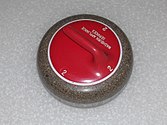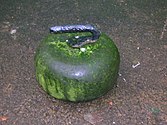Curling
 Curling games taking place during the 2005 Tim Hortons Brier | |
| Highest governing body | World Curling Federation |
|---|---|
| Nicknames | Chess On Ice, The Roaring Game |
| First played | Approximately late medieval Scotland |
| Registered players | est. 1,500,000[1] |
| Characteristics | |
| Contact | No |
| Team members | 4 per team (2 in mixed doubles) |
| Mixed gender | Yes; see mixed curling |
| Type | Precision and accuracy |
| Equipment | Curling brooms, stones (rocks), curling shoes |
| Venue | Curling sheet |
| Glossary | Glossary of curling |
| Presence | |
| Olympic |
|
| Paralympic | Wheelchair curling officially added in 2006. |
Curling is a sport in which players slide stones on a sheet of ice towards a target area which is segmented into four concentric circles. It is related to bowls, boules and shuffleboard. Two teams, each with four players, take turns sliding heavy, polished granite stones, also called rocks, across the ice curling sheet towards the house, a circular target marked on the ice.[2] Each team has eight stones, with each player throwing two. The purpose is to accumulate the highest score for a game; points are scored for the stones resting closest to the centre of the house at the conclusion of each end, which is completed when both teams have thrown all of their stones. A game usually consists of eight or ten ends.
The curler can induce a curved path by causing the stone to slowly turn as it slides, and the path of the rock may be further influenced by two sweepers with brooms who accompany it as it slides down the sheet, using the brooms to alter the state of the ice in front of the stone. Sweeping a rock makes it curl less, and decreases the friction that slows the rock down. A great deal of strategy and teamwork go into choosing the ideal path and placement of a stone for each situation, and the skills of the curlers determine the degree to which the stone will achieve the desired result. This gives curling its nickname of "chess on ice".[3][4]
Contents
1 History
1.1 Olympic curling
2 Equipment
2.1 Curling sheet
2.2 Curling stone
2.3 Curling broom
2.4 Shoes
2.5 Other equipment
3 Gameplay
3.1 Delivery
3.2 Sweeping
3.3 Burning a stone
3.4 Types of shots
3.5 Free guard zone
3.6 Hammer
3.7 Strategy
3.8 Conceding a game
3.9 Dispute resolution
4 Scoring
5 Curling culture
5.1 Good sportsmanship
5.2 Accessibility in curling
6 Terminology
7 Champions and major championships
8 Notable curling clubs
9 In popular culture
10 See also
11 Notes
12 Further reading
13 External links
History
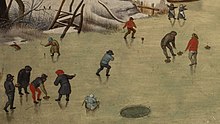
Detail from a reproduction of Winter Landscape with a Bird Trap (Bruegel, 1565)
Evidence that curling existed in Scotland in the early 16th century includes a curling stone inscribed with the date 1511 uncovered (along with another bearing the date 1551) when an old pond was drained at Dunblane, Scotland.[5] The world's oldest curling stone and the world's oldest football are now kept in the same museum (the Stirling Smith Art Gallery and Museum) in Stirling.[6] The first written reference to a contest using stones on ice coming from the records of Paisley Abbey, Renfrewshire, in February 1541.[7] Two paintings, "Winter Landscape with a Bird Trap" and "The Hunters in the Snow" (both dated 1565) by Pieter Bruegel the Elder depict Flemish peasants curling, albeit without brooms; Scotland and the Low Countries had strong trading and cultural links during this period, which is also evident in the history of golf.[8]

A curling match at Eglinton Castle, Ayrshire, Scotland in 1860. The curling house is located to the left of the picture.
The word curling first appears in print in 1620 in Perth, Scotland, in the preface and the verses of a poem by Henry Adamson.[9][10] The sport was (and still is, in Scotland and Scottish-settled regions like southern New Zealand) also known as "the roaring game" because of the sound the stones make while traveling over the pebble (droplets of water applied to the playing surface).[11] The verbal noun curling is formed from the Scots (and English) verb curl,[12] which describes the motion of the stone.
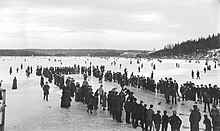
Group of people curling on a lake in Dartmouth, Nova Scotia, Canada, c. 1897
Kilsyth Curling Club claims to be the first club in the world, having been formally constituted in 1716;[13] it is still in existence today.[14] Kilsyth also claims the oldest purpose-built curling pond in the world at Colzium, in the form of a low dam creating a shallow pool some 100 by 250 metres (330 by 820 ft) in size. The International Olympic Committee recognises the Royal Caledonian Curling Club (founded as the Grand Caledonian Curling Club in 1838) as developing the first official rules for the sport.[15]
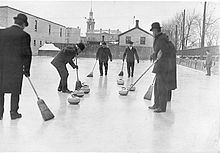
Men curling in Toronto, Ontario, Canada, in 1909
In the early history of curling, the playing stones were simply flat-bottomed stones from rivers or fields, which lacked a handle and were of inconsistent size, shape and smoothness.[16][17] Some early stones had holes for a finger and the thumb, akin to ten-pin bowling balls.[18] Unlike today, the thrower had little control over the 'curl' or velocity and relied more on luck than on precision, skill and strategy. The sport was often played on frozen rivers although purpose-built ponds were later created in many Scottish towns.[19] For example, the Scottish poet David Gray describes whisky drinking curlers on the Luggie Water at Kirkintilloch.[20][21]

Curling on Lake of Menteith from 2010. The last official Grand Match was held here in 1979.[22]
In Darvel, East Ayrshire, the weavers relaxed by playing curling matches using the heavy stone weights from the looms' warp beams, fitted with a detachable handle for the purpose. Many a wife would keep her husband's brass curling stone handle on the mantelpiece, brightly polished until the next time it was needed.[23] Central Canadian curlers often used 'irons' rather than stones until the early 1900s; Canada is the only country known to have done so, while others experimented with wood or ice-filled tins.[24]
Outdoor curling was very popular in Scotland between the 16th and 19th centuries because the climate provided good ice conditions every winter. Scotland is home to the international governing body for curling, the World Curling Federation in Perth, which originated as a committee of the Royal Caledonian Curling Club, the mother club of curling.
Today, the sport is most firmly established in Canada, having been taken there by Scottish emigrants. The Royal Montreal Curling Club, the oldest established sports club still active in North America,[25] was established in 1807. The first curling club in the United States was established in 1830, and the sport was introduced to Switzerland and Sweden before the end of the 19th century, also by Scots. Today, curling is played all over Europe and has spread to Brazil, Japan, Australia, New Zealand, China, and Korea.[26]
The first world championship for curling was limited to men and was known as the Scotch Cup, held in Falkirk and Edinburgh, Scotland, in 1959. The first world title was won by the Canadian team from Regina, Saskatchewan, skipped by Ernie Richardson. (The skip is the team member who calls the shots; see below.)
Curling was one of the first sports that was popular with women and girls.[27]
Olympic curling

Curling at Youth Olympic Games 2012

Curling pictogram
Curling has been a medal sport in the Winter Olympic Games since the 1998 Winter Olympics. It currently includes men's, women's and mixed doubles tournaments (the mixed tournament was held for the first time in 2018).[28]
In February 2002, the International Olympic Committee retroactively decided that the curling competition from the 1924 Winter Olympics (originally called Semaine des Sports d'Hiver, or International Winter Sports Week) would be considered official Olympic events and no longer be considered demonstration events. Thus, the first Olympic medals in curling, which at the time was played outdoors, were awarded for the 1924 Winter Games, with the gold medal won by Great Britain, two silver medals by Sweden, and the bronze by France. A demonstration tournament was also held during the 1932 Winter Olympic Games between four teams from Canada and four teams from the United States, with Canada winning 12 games to 4.[29][30]
Since the 1998 Olympics, Canada has dominated the sport with their men's teams winning gold in 2006, 2010, and 2014, and silver in 1998 and 2002. The women's team won gold in 1998 and 2014, a silver in 2010, and a bronze in 2002 and 2006. The mixed doubles team won gold in 2018.
Equipment
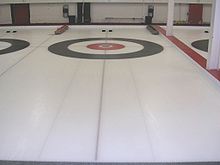
The playing area in curling is shown here. Stones must land between the hog line (bottom of photo) and the back line (behind the rings) and may not contact boards or out lines (on the sides) at any time during travel.
Curling sheet

Detail of the curling sheet. The 12-foot circle covers the backline.
The playing surface or curling sheet is defined by the World Curling Federation Rules of Curling.[31] It is a rectangular area of ice, carefully prepared to be as flat and level as possible, 146 to 150 feet (45 to 46 m) in length by 14.5 to 16.5 feet (4.4 to 5.0 m) in width. The shorter borders of the sheet are called the backboards. Because of the elongated shape, several sheets may be laid out side by side in the same arena, allowing multiple games to be played simultaneously.
A target, the house, is centred on the intersection of the centre line, drawn lengthwise down the centre of the sheet and the tee line, drawn 16 feet (4.9 m) from, and parallel to, the backboard. These lines divide the house into quarters. The house consists of a centre circle (the button) and three concentric rings, of diameters 4, 8 and 12 feet, formed by painting or laying coloured vinyl sheet under the ice and are usually distinguished by colour. A stone must at least touch the outer ring in order to score (see Scoring below); otherwise the rings are merely a visual aid for aiming and judging which stone is closer to the button.
Two hog lines are drawn 37 feet (11 m) from, and parallel to, the backboard.
The hacks, which give the thrower something to push against when making the throw, are fixed 12 feet (3.7 m) behind each button. On indoor rinks, there are usually two fixed hacks, rubber-lined holes, one on each side of the centre line, with the inside edge no more than 3 inches (76 mm) from the centre line and the front edge on the hack line. A single moveable hack may also be used.
The ice may be natural but is usually frozen by a refrigeration plant pumping a brine solution through numerous pipes fixed lengthwise at the bottom of a shallow pan of water. Most curling clubs have an ice maker whose main job is to care for the ice. At the major curling championships, ice maintenance is extremely important. Large events, such as the Brier or other national/international championships, are typically held in an arena that presents a challenge to the ice maker, who must constantly monitor and adjust the ice and air temperatures as well as air humidity levels to ensure a consistent playing surface. It is common for each sheet of ice to have multiple sensors embedded in order to monitor surface temperature, as well as probes set up in the seating area (to monitor humidity) and in the compressor room (to monitor brine supply and return temperatures). The surface of the ice is maintained at a temperature of around 23 °F (−5 °C).[32]
A key part of the preparation of the playing surface is the spraying of water droplets onto the ice, which form pebble on freezing. The pebbled ice surface resembles an orange peel, and the stone moves on top of the pebbled ice.[33] As the stone moves over the pebble, any rotation of the stone causes it to curl to the inside or outside. The amount of curl (commonly referred to as the feet of curl) can change during a game as the pebble wears; the ice maker must monitor this and be prepared to scrape and re-pebble the surface prior to each game.[34]
Curling stone
The curling stone (also sometimes called a rock in North America) is made of granite and is specified by the World Curling Federation, which requires a weight between 38 and 44 pounds (17.24 and 19.96 kg), a maximum circumference of 36 inches (914.4 mm) and a minimum height of 4.5 inches (114.3 mm).[31] The only part of the stone in contact with the ice is the running surface, a narrow, flat annulus or ring, 0.25 to 0.50 inches (6.4 to 12.7 mm) wide and about 5 inches (130 mm) in diameter; the sides of the stone bulge convex down to the ring and the inside of the ring is hollowed concave to clear the ice. This concave bottom was first proposed by J. S. Russell of Toronto, Ontario, Canada sometime after 1870, and was subsequently adopted by Scottish stone manufacturer Andrew Kay.[24]
@media all and (max-width:720px){.mw-parser-output .tmulti>.thumbinner{width:100%!important;max-width:none!important}.mw-parser-output .tmulti .tsingle{float:none!important;max-width:none!important;width:100%!important;text-align:center}}
The granite for the stones comes from two sources: Ailsa Craig, an island off the Ayrshire coast of Scotland, and the Trefor Granite Quarry in Wales.
Ailsa Craig is the traditional source and produces two types of granite, Blue Hone and Ailsa Craig Common Green. Blue Hone has very low water absorption, which prevents the action of repeatedly freezing water from eroding the stone.[35]Ailsa Craig Common Green is a lesser quality granite than Blue Hone. In the past, most curling stones were made from Blue Hone but the island is now a wildlife reserve and the quarry is restricted by environmental conditions that exclude blasting.
Kays of Scotland has been making curling stones in Mauchline, Ayrshire, since 1851 and has the exclusive rights to the Ailsa Craig granite, granted by the Marquess of Ailsa, whose family has owned the island since 1560. According to the 1881 Census, Andrew Kay employed 30 people in his curling stone factory in Mauchline.[36] The last harvest of Ailsa Craig granite by Kays took place in 2013, after a hiatus of 11 years; 2,000 tons were harvested, sufficient to fill anticipated orders through at least 2020. Kays have been involved in providing curling stones for the Winter Olympics since Chamonix in 1924 and has been the exclusive manufacturer of curling stones for the Olympics since the 2006 Winter Olympics.[37][38]
Trefor granite comes from the Yr Eifl or Trefor Granite Quarry in the village of Trefor on the north coast of the Llŷn Peninsula in Gwynedd, Wales and has produced granite since 1850. Trefor granite comes in shades of pink, blue and grey.[39] The quarry supplies curling stone granite exclusively to the Canadian, Canada Curling Stone Co., which has been producing stones since 1992 and supplied the stones for the 2002 Winter Olympics.
A handle is attached by a bolt running vertically through a hole in the centre of the stone. The handle allows the stone to be gripped and rotated upon release; on properly prepared ice the rotation will bend (curl) the path of the stone in the direction in which the front edge of the stone is turning, especially as the stone slows. Handles are coloured to identify each team, two popular colours in major tournaments being red and yellow.
In competition, an electronic handle known as the eye on the hog may be fitted to detect hog line violations. This electronically detects whether the thrower's hand is in contact with the handle as it passes the hog line and indicates a violation by lights at the base of the handle. The eye on the hog eliminates human error and the need for hog line officials. It is mandatory in high-level national and international competition, but its cost, around US$650 each, currently puts it beyond the reach of most club curling.
Curling broom
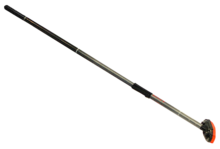
Curling broom
The curling broom, or brush, is used to sweep the ice surface in the path of the stone (see sweeping) and is also often used as a balancing aid during delivery of the stone.
Prior to the 1950s, most curling brooms were made of corn strands and were similar to household brooms of the day. In 1958, Fern Marchessault of Montreal inverted the corn straw in the centre of the broom. This style of corn broom was referred to as the Blackjack.[40]
Artificial brooms made from man-made fabrics rather than corn, such as the Rink Rat, also became common later during this time period. Prior to the late sixties, Scottish curling brushes were used primarily by some of the Scots, as well as by recreational and elderly curlers, as a substitute for corn brooms, since the technique was easier to learn. In the late sixties, competitive curlers from Calgary, Alberta, such as John Mayer, Bruce Stewart, and, later, the world junior championship teams skipped by Paul Gowsell, proved that the curling brush could be just as (or more) effective without all the blisters common to corn broom use.[40] During that time period, there was much debate in competitive curling circles as to which sweeping device was more effective: brush or broom. Eventually, the brush won out with the majority of curlers making the switch to the less costly and more efficient brush. Today, brushes have replaced traditional corn brooms at every level of curling; it is rare now to see a curler using a corn broom on a regular basis.
Curling brushes may have fabric, hog hair, or horsehair heads. Modern curling brush handles are usually hollow tubes made of fibreglass or carbon fibre instead of a solid length of wooden dowel. These hollow tube handles are lighter and stronger than wooden handles, allowing faster sweeping and also enabling more downward force to be applied to the broom head with reduced shaft flex. New, "directional fabric" brooms, which players are worried will alter the fundamentals of the sport by reducing the level of skill required, have been accused of giving players an unfair advantage.[41] The new brooms were temporarily banned by the World Curling Federation and Curling Canada[42] for the 2015–2016 season. The new brooms give sweepers unprecedented control over the direction the stone goes.[43]
Shoes

Curling shoes, showing a slider sole
Curling shoes are similar to ordinary athletic shoes except that they have dissimilar soles; the slider shoe (usually known as a "slider") is designed for the sliding foot and the "gripper shoe" (usually known as a gripper) for the hack foot.
The slider is designed to slide and typically has a Teflon sole. It is worn by the thrower during delivery from the hack and by sweepers or the skip to glide down the ice when sweeping or otherwise traveling down the sheet quickly. Stainless steel was once common for slider soles, and "red brick" sliders with lateral blocks of PVC on the sole are also available. Most shoes have a full-sole sliding surface, but some shoes have a sliding surface covering only the outline of the shoe and other enhancements with the full-sole slider. Some shoes have small disc sliders covering the front and heel portions or only the front portion of the foot, which allow more flexibility in the sliding foot for curlers playing with tuck deliveries.[44] When a player is not throwing, the player's slider shoe can be temporarily rendered non-slippery by using a slip-on gripper. Ordinary athletic shoes may be converted to sliders by using a step-on or slip-on Teflon slider or by applying electrical or gaffer tape directly to the sole or over a piece of cardboard. This arrangement often suits casual or beginning players.
The gripper is worn by the thrower on the hack foot during delivery and is designed to grip the ice. It may have a normal athletic shoe sole or a special layer of rubbery material applied to the sole of a thickness to match the sliding shoe. The toe of the hack foot shoe may also have a rubberised coating on the top surface or a flap that hangs over the toe to reduce wear on the top of the shoe as it drags on the ice behind the thrower.
Other equipment
Other types of equipment include:
- Curling pants, made to be stretchy to accommodate the curling delivery.
- A stopwatch to time the stones over a fixed distance to calculate their speed. Stopwatches can be attached either to clothing or the broom.
- Curling gloves and mittens, to keep the hands warm and improve grip on the broom.
Gameplay
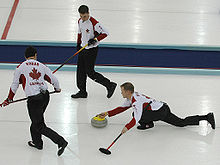
At the 2006 Winter Olympics, Mark Nichols from Team Canada delivers a stone while his teammates look on, ready to begin sweeping. The curler uses his broom to help keep his balance during delivery.
The purpose of a game is to score points by getting stones closer to the house centre, or the "button", than the other team's stones.[45] Players from either team alternate in taking shots from the far side of the sheet. An end is complete when all eight rocks from each team have been delivered, a total of sixteen stones. If the teams are tied at the end of the game, play continues for as many ends as may be required to break the tie. The winner is the team with the highest score after all ends have been completed (see Scoring below). A game may be conceded if considered unwinnable.
International competitive games are generally ten ends, so most of the national championships that send a representative to the World Championships or Olympics also play ten ends. However, there is a movement on the World Curling Tour to make the games only eight ends.[46] Most tournaments on that tour are eight ends, as are the vast majority of recreational games.
In international competition, each side is given 73 minutes to complete all of its throws. Each team is also allowed two minute-long timeouts per 10-end game. If extra ends are required, each team is allowed 10 minutes of playing time to complete its throws and one added 60-second timeout for each extra end. However, the "thinking time" system, in which the delivering team's game timer stops as soon as the shooter's rock crosses the t-line during the delivery, is becoming more popular, especially in Canada. This system allows each team 38 minutes per 10 ends, or 30 minutes per 8 ends, to make strategic and tactical decisions, with 4 minutes and 30 seconds an end for extra ends.[47] The "thinking time" system was implemented after it was recognized that teams playing aggressively (using draws and other low-weight shots which take more time for the stones to come to rest) were essentially being penalized in terms of the time they had available compared to teams which primarily use hits which require far less time per shot.
Delivery
The process of sliding a stone down the sheet is known as the delivery.
The skip, or the captain of the team, will usually determine the required weight, turn, and line of the stone. These will be influenced by the tactics at this point in the game, which may involve taking out, blocking or tapping another stone.
- The weight of the stone is its velocity, which depends on the leg drive of the delivery rather than the arm.
- The turn or curl is the rotation of the stone, which gives it a curved trajectory.
- The line is the direction of the throw ignoring the effect of the turn.
The skip may communicate the weight, turn, line, and other tactics by calling or tapping a broom on the ice. In the case of a takeout, guard, or a tap, the skip will indicate the stones involved.
Before delivery, the running surface of the stone is wiped clean and the path across the ice swept with the broom if necessary, because any dirt on the bottom of a stone or in its path can alter the trajectory and ruin the shot. Intrusion by a foreign object is called a pick-up or pick.
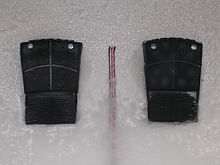
Players must push out of the hack to deliver their stones. 95% of hacks in use around the world are Marco Hacks, which were invented in the 1980s by Marco Ferraro.[48]

Outdoor curling on Stormont Loch.[49] The stone is delivered from an iron crampit[50] rather than the hack used indoors
The thrower throws from the hack. Another player, usually the skip, is stationed behind the button to determine the tactics, weight, turn, and line, and the other two may sweep in front of the stone to influence the trajectory (see Sweeping, below). The players, with the exception of the skip, take turns throwing and sweeping; when one player (e.g., the lead) throws, the players not throwing (the second and third) sweep. When the skip throws, the third, or vice-skip, takes his or her role.
The thrower's gripper shoe (with the non-slippery sole) is positioned against one of the hacks; for a right-handed curler the right foot is placed against the left hack and vice versa for a left-hander. The thrower, now in the hack, lines the body up with shoulders square to the skip's broom at the far end for line.
The stone is placed in front of the foot now in the hack. Rising slightly from the hack, the thrower pulls the stone back (some older curlers may actually raise the stone in this backward movement) then lunges smoothly out from the hack pushing the stone ahead while the slider foot is moved in front of the gripper foot, which trails behind. The thrust from this lunge determines the weight and hence the distance the stone will travel. While not compulsory, most curlers deliver the stone while sliding out from the hack. Balance may be assisted by a broom held in the free hand with the back of the broom down so that it slides. One older writer suggests the player keep "a basilisk glance" at the mark.[51]
There are two current types of delivery, the common flat-foot deliver as well as the Manitoba tuck delivery where the curler slides on the front ball of his foot.[52]
The stone is released as the thrower approaches the hog line, at which point the turn is imparted by a slight clockwise or counter-clockwise twist of the handle from around the two or ten o'clock position to the twelve o'clock on release. A typical rate of turn is about 2 1⁄2 rotations before coming to a rest.
The stone must be released before its front edge crosses the near hog line, and it must clear the far hog line or else be removed from play (hogged); an exception is made if a stone fails to come to rest beyond the far hog line after rebounding from a stone in play just past the hog line. The release rule is rarely enforced in club play unless abuse is suspected. However, in major tournaments it is strictly enforced; the "eye on the hog" sensor in the stone will indicate whether the stone has been legally thrown or not. The lights on the stone handle will either light up green, indicating that the stone has been legally thrown, or red, in which case the illegally thrown stone will be immediately pulled from play instead of waiting for the stone to come to rest.
Sweeping
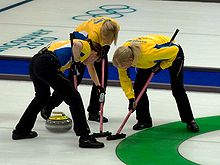
The skip of Team Sweden joins the front end in sweeping a stone into the house at the 2010 Winter Olympics in Vancouver
After the stone is delivered, its trajectory is still influenced by the two sweepers under instruction from the skip. Sweeping is done for several reasons: to reduce friction underneath the stone, to decrease the amount of curl, and to clean debris from the stone's path.[53] The stones curl more as they slow down, so sweeping early in travel tends to increase distance as well as straighten the path, and sweeping after sideways motion is established can increase the sideways distance. When sweeping, pressure and speed of the brush head are key in slightly increasing the layer of moisture that builds up under the stone.
One of the basic technical aspects of curling is knowing when to sweep. When the ice in front of the stone is swept, a stone will usually travel both farther and straighter. In some situations, one of the two alterations in path is not desirable. For example, a stone may have too much weight, but require sweeping to prevent curling into a guard. The team must decide which is better: getting by the guard but traveling too far, or hitting the guard.
Much of the yelling that goes on during a curling game is the skip calling the line of the shot and the sweepers calling the weight. The skip evaluates the path of the stone and calls to the sweepers to sweep as necessary to maintain the intended track. The sweepers themselves are responsible for judging the weight of the stone, ensuring the length of travel is correct and communicating the weight of the stone back to the skip. Some teams use stopwatch timing, from back line to the nearest hog line as a sweeping aid. Many teams use the Number System to communicate in which of 10 playable zones it is estimated the stone will stop.
Usually, the two sweepers will be on opposite sides of the stone's path, although depending on which side the sweepers' strengths lie this may not always be the case. Speed and pressure are vital to sweeping. In gripping the broom, one hand should be one third of the way from the top (non-brush end) of the handle while the other hand should be one third of the way from the head of the broom. The angle of the broom to the ice should be so that the most force possible can be exerted on the ice. The precise amount of pressure may vary from relatively light brushing ("just cleaning" - to ensure debris will not alter the stone's path) to maximum-pressure scrubbing.
Sweeping is allowed anywhere on the ice up to the tee line, as long as it is only for one's own team stones. Once the leading edge of a team stone crosses the tee line only one player may sweep it. Additionally, when a stone crosses the tee line, one player from the other team is allowed to sweep it. This is the only case that a stone may be swept by an opposing team member. In international rules, this player must be the skip; or if the skip is throwing, then the sweeping player must be the third.
Burning a stone
Occasionally, players may accidentally touch a stone with their broom or a body part. This is often referred to as burning a stone. Players touching a stone in such a manner are expected to call their own infraction as a matter of good sportsmanship. Touching a stationary stone when no stones are in motion (there is no delivery in progress) is not an infraction (unless the stationary stone is struck in such a manner that its position is altered), and is a common way for the skip to indicate a stone that is to be taken out.
When a stone is touched when stones are in play, the remedies vary[31][54] between placing the stones as they end up after the touch, replacing the stones as they would have been if no stone were touched, or removal of the touched stone from play. In non-officiated league play, the skip of the non-offending team has the final say on where the stones are placed after the infraction.
Types of shots

Two ways to get the button with the last stone: a draw on the left (outturn for right-handed delivery), and a hit and roll on the right.
Many different types of shots are used to carefully place stones for strategic or tactical reasons; they fall into three fundamental categories as follows:
Guards are thrown in front of the house in the free guard zone, usually to protect the shot-rock (the stone closest to the button at the time) or to make the opposing team's shot difficult. Guard shots include the centre-guard, on the centreline and the corner-guards to the left or right sides of the centre line. See Free Guard Zone below.
Draws are thrown only to reach the house. Draw shots include raise and angle-raise, come-around, and freeze shots.
Takeouts are intended to remove stones from play and include the peel, hit-and-roll and double shots.
For a more complete listing, see Glossary of curling terms.
Free guard zone
Until five stones have been played (three from the side without hammer, and two from the side with hammer), stones in the free guard zone (stones left in the area between the hog and tee lines, excluding the house) may not be removed by an opponent's stone, although they can be moved as long as they are not taken out of play. These are known as guard rocks. If a guard rock is removed under this rule, it is placed back in the positions it was in before the shot was thrown, and the opponent's stone is removed from play and cannot be replayed. This rule is known as the five-rock rule or the free guard zone rule (previous versions of the free guard zone rule only limited removing guards from play in the first three or four rocks, known as the "three-rock rule" and "four-rock rule" respectively).
This rule, a relatively recent addition to curling, was added in response to a strategy of "peeling" opponents' guard stones (knocking them out of play at an angle that caused the shooter's stone to also roll out of play, leaving no stones on the ice). A team in the lead would often employ this strategy during the game. By knocking all stones out, the opponents could at best score one point (if they had the hammer). Alternatively, the team with the hammer could peel rock after rock, which would blank the end, keeping the last rock advantage for another end. This strategy had developed (mostly in Canada) as ice-makers had become skilled at creating a predictable ice surface and the adoption of brushes allowed greater control over the rock. While a sound strategy, this made for an unexciting game. Observers at the time noted that if two teams equally skilled in the peel game faced each other on good ice, the outcome of the game would be predictable from who won the coin flip to have last rock (or had earned it in the schedule) at the beginning of the game. The 1990 Brier was considered by many curling fans as boring to watch because of the amount of peeling and the quick adoption of the Free Guard Zone the following year reflected how disliked this aspect of the game had become.
The free guard zone was originally called the Modified Moncton Rule and was developed from a suggestion made by Russ Howard for the Moncton 100 cashspiel (with the richest prize ever awarded at the time in a tournament) in Moncton, New Brunswick, in January 1990. "Howard's Rule" (later known as the Moncton Rule), used for the tournament and based on a practice drill his team used, had the first four rocks in play unable to be removed no matter where they were at any time during the end. This method of play was altered by restricting the area in which a stone was protected to the free guard zone only for the first four rocks thrown and adopted as a Four-rock Free Guard Zone for international competition shortly after. Canada kept to the traditional rules until a three-rock Free Guard Zone rule was adopted for the 1993–94 season. After several years of having the three-rock rule used for the Canadian championships and the winners then having to adjust to the four-rock rule in the World Championships, the Canadian Curling Association adopted the four-rock Free Guard Zone in the 2002–2003 season.
One strategy that has been developed by curlers in response to the Free Guard Zone (Kevin Martin from Alberta is one of the best examples) is the "tick" game, where a shot is made attempting to knock (tick) the guard to the side, far enough that it is difficult or impossible to use but still remaining in play while the shot itself goes out of play. The effect is functionally identical to peeling the guard but significantly harder, as a shot that hits the guard too hard (knocking it out of play) results in its being replaced, while not hitting it hard enough can result in its still being tactically useful for the opposition. There is also a greater chance that the shot will miss the guard entirely because of the greater accuracy required to make the shot. Because of the difficulty of making this type of shot, only the best teams will normally attempt it, and it does not dominate the game the way the peel formerly did. Steve Gould from Manitoba popularized ticks played across the face. These are easier to make because they impart less speed on the object stone, therefore increasing the chance that it remains in play even if a bigger chunk of it is hit.
With the tick shot reducing the effectiveness of the four-rock rule, the Grand Slam of Curling series of bonspiels adopted a five-rock rule in 2014.[55] In 2017, the five-rock rule was adopted by the World Curling Federation and member organizations for official play, beginning in the 2018-19 season.[56][57]
Hammer
Last-rock or last-stone advantage in an end is called the hammer. Before the game, teams typically decide who gets the hammer in the first end either by chance (such as a coin toss), by a "draw-to-the-button" contest, where a representative of each team shoots to see who gets closer to the centre of the rings, or, particularly in tournament settings like the Winter Olympics, by a comparison of each team's win-loss record. In all subsequent ends, the hammer belongs to the team that did not score in the preceding end. In the event that neither team scores, the hammer remains with the same team. Naturally, it is easier to score points with the hammer than without; in tournament play, the team with the hammer generally tries to score two or more points. If only one point is possible, the skip will often try to avoid scoring at all in order to retain the hammer until the next end, when two or more points may lie. This is called a blank end. Scoring without the hammer is commonly referred to as stealing, or a steal, and is much more difficult.
Strategy
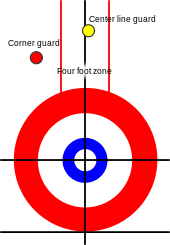
Diagram of the play area in curling, showing the four-foot zone, corner guard, and centre line guard
Curling is a game of strategy, tactics and skill. The strategy depends on the team's skill, the opponent's skill, the conditions of the ice, the score of the game, how many ends remain and whether the team has last-stone advantage (the hammer). A team may play an end aggressively or defensively. Aggressive playing will put a lot of stones in play by throwing mostly draws; this makes for an exciting game and is very risky but the reward can be very great. Defensive playing will throw a lot of hits preventing a lot of stones in play; this tends to be less exciting and less risky. A good drawing team will usually opt to play aggressively, while a good hitting team will opt to play defensively.
If a team does not have the hammer in an end, it will opt to try to clog up the four-foot zone in the house to deny the opposing team access to the button. This can be done by throwing "centre line" guards in front of the house on the centre line, which can be tapped into the house later or drawn around. If a team has the hammer, they will try to keep this four-foot zone free so that they have access to the button area at all times. A team with the hammer may throw a corner guard as their first stone of an end placed in front of the house but outside the four-foot zone to utilize the free guard zone. Corner guards are key for a team to score two points in an end, because they can either draw around it later or hit and roll behind it, making the opposing team's shot to remove it more difficult.
Ideally, the strategy in an end for a team with the hammer is to score two points or more. Scoring one point is often a wasted opportunity, as they will then lose last-rock advantage for the next end. If a team cannot score two points, they will often attempt to "blank an end" by removing any leftover opposition rocks and rolling out; or, if there are no opposition rocks, just throwing the rock through the house so that no team scores any points, and the team with the hammer can try again the next end to score two or more with it. Generally, a team without the hammer would want to either force the team with the hammer to only one point (so that they can get the hammer back) or "steal" the end by scoring one or more points of their own.[58]
Generally, the larger the lead a team will have in a game, the more defensively they should play. By hitting all of the opponent's stones, it removes opportunities for their getting multiple points, therefore defending the lead. If the leading team is quite comfortable, leaving their own stones in play can also be dangerous. Guards can be drawn around by the other team, and stones in the house can be tapped back (if they are in front of the tee line) or frozen onto (if they are behind the tee line). A frozen stone is difficult to remove, because it is "frozen" (in front of and touching) to the opponents stone. At this point, a team will opt for "peels", meaning that the stones they throw will be to not only hit their opposition stones, but to roll out of play as well. Peels are hits that are thrown with the most amount of power.
Conceding a game
It is not uncommon at any level for a losing team to terminate the match before all ends are completed if it believes it no longer has a realistic chance of winning. Competitive games end once the losing team has "run out of rocks"—that is, once it has fewer stones in play and available for play than the number of points needed to tie the game.
Dispute resolution

Measuring which stone is closest to the centre of the house
Most decisions about rules are left to the skips, although in official tournaments, decisions may be left to the officials. However, all scoring disputes are handled by the vice skip. No players other than the vice skip from each team should be in the house while score is being determined. In tournament play, the most frequent circumstance in which a decision has to be made by someone other than the vice skip is the failure of the vice skips to agree on which stone is closest to the button. An independent official (supervisor at Canadian and World championships) then measures the distances using a specially designed device that pivots at the centre of the button. When no independent officials are available, the vice skips measure the distances.
Scoring

A typical curling scoreboard used at clubs, which use a method of scoring different from the ones used on television
The winner is the team having the highest number of accumulated points at the completion of ten ends. Points are scored at the conclusion of each of these ends as follows: when each team has thrown its eight stones, the team with the stone closest to the button wins that end; the winning team is then awarded one point for each of its own stones lying closer to the button than the opponent's closest stone.
Only stones that are in the house are considered in the scoring. A stone is in the house if it lies within the 12-foot (3.7 m) zone or any portion of its edge lies over the edge of the ring. Since the bottom of the stone is rounded, a stone just barely in the house will not have any actual contact with the ring, which will pass under the rounded edge of the stone, but it still counts. This type of stone is known as a biter.
It may not be obvious to the eye which of two rocks is closer to the button (centre) or if a rock is actually biting or not. There are specialized devices to make these determinations, but these cannot be brought out until after an end is completed. Therefore, a team may make strategic decisions during an end based on assumptions of rock position that turn out to be incorrect.
The score is marked on a scoreboard, of which there are two types; the baseball type and the club scoreboard.
The baseball-style scoreboard was created for televised games for audiences not familiar with the club scoreboard. The ends are marked by columns 1 through 10 (or 11 for the possibility of an extra end to break ties) plus an additional column for the total. Below this are two rows, one for each team, containing the team's score for that end and their total score in the right hand column.
The club scoreboard is traditional and used in most curling clubs. Scoring on this board only requires the use of (up to) 11 digit cards, whereas with baseball-type scoring an unknown number of multiples of the digits (especially low digits like 1) may be needed. The numbered centre row represents all possible accumulated scores, and the numbers placed in the team rows represent the end in which that team achieved that cumulative score. If the red team scores three points in the first end (called a three-ender), then a 1 (indicating the first end) is placed beside the number 3 in the red row. If they score two more in the second end, then a 2 will be placed beside the 5 in the red row, indicating that the red team has five points in total (3+2). This scoreboard works because only one team can get points in an end. However, some confusion may arise if neither team scores points in an end, this is called a blank end. The blank end numbers are usually listed in the farthest column on the right in the row of the team that has the hammer (last rock advantage), or on a special spot for blank ends.
The following example illustrates the difference between the two types. The example illustrates the men's final at the 2006 Winter Olympics.
| Team | 1 | 2 | 3 | 4 | 5 | 6 | 7 | 8 | 9 | 10 | Final |
| 0 | 2 | 1 | 1 | 0 | 6 | 0 | 0 | x | x | 10 | |
| 2 | 0 | 0 | 0 | 1 | 0 | 0 | 1 | x | x | 4 |
| 2 | 3 | 4 | 6 | |||||||||||||
| Points | 1 | 2 | 3 | 4 | 5 | 6 | 7 | 8 | 9 | 10 | 11 | 12 | 13 | 14 | 15 | Blank ends |
| 1 | 5 | 8 | 7 |
Eight points – all the rocks thrown by one team counting – is the highest score possible in an end, and is known as an "eight-ender" or "snowman". Scoring an eight-ender against a relatively competent team is very difficult; in curling, it is considered the equivalent of pitching a perfect game in baseball. Probably the best-known snowman came at the 2006 Players' Championships. Future (2007) World Champion Kelly Scott scored eight points in one of her games against 1998 World bronze medalist Cathy King.[59][60]
Curling culture

The Curlers (1835) by Sir George Harvey

Curling;—a Scottish Game, at Central Park (1862) by John George Brown

Curling at Carsebreck (1899) by Charles Martin Hardie
Competition teams are normally named after the skip, for example, Team Martin after skip Kevin Martin. Amateur league players can (and do) creatively name their teams, but when in competition (a bonspiel) the official team will have a standard name.
Top curling championships are typically played by all-male or all-female teams. It is known as mixed curling when a team consists of two men and two women. For many years, in the absence of world championship or Olympic mixed curling events, national championships (of which the Canadian Mixed Curling Championship was the most prominent) were the highest-level mixed curling competitions. However, a European Mixed Curling Championship was inaugurated in 2005, a World Mixed Doubles Curling Championship was established in 2008, and the European Mixed Championship was replaced with the World Mixed Curling Championship in 2015. A mixed tournament was held at the Olympic level for the first time in 2018, although it was a doubles tournament, not a four-person.
Curling tournaments may use the Schenkel system for determining the participants in matches.
Curling is played in many countries, including Canada, the United Kingdom (especially Scotland), the United States, Norway, Sweden, Switzerland, Denmark, Finland and Japan, all of which compete in the world championships.
Curling has been depicted by many artists including: George Harvey,[61][62] John Levack,[63] The Dutch School,[64] Charles Martin Hardie,[65] John Elliot Maguire,[66] John McGhie,[67] and John George Brown.[68]
Curling is particularly popular in Canada. Improvements in ice making and changes in the rules to increase scoring and promote complex strategy have increased the already high popularity of the sport in Canada, and large television audiences watch annual curling telecasts, especially the Scotties Tournament of Hearts (the national championship for women), the Tim Hortons Brier (the national championship for men), and the women's and men's world championships.
Despite the Canadian province of Manitoba's small population (ranked 5th of 10 Canadian provinces), Manitoban teams have won the Brier more times than teams from any other province. The Tournament of Hearts and the Brier are contested by provincial and territorial champions, and the world championships by national champions.
Curling is the provincial sport of Saskatchewan. From there Ernie Richardson and his family team dominated Canadian and international curling during the late 1950s and early 1960s and have been considered to be the best male curlers of all time.[69]Sandra Schmirler led her team to the first ever gold medal in women's curling in the 1998 Winter Olympics. When she died two years later from cancer, over 15,000 people attended her funeral, and it was broadcast on national television.
Good sportsmanship
More so than in many other team sports, good sportsmanship, often referred to as the "Spirit of Curling", is an integral part of curling. The Spirit of Curling also leads teams to congratulate their opponents for making a good shot, strong sweeping or spectacular form. Perhaps most importantly, the Spirit of Curling dictates that one never cheers mistakes, misses or gaffes by one's opponent (unlike most team sports) and one should not celebrate one's own good shots during the game beyond modest acknowledgement of the shot such as a head nod, fist bump or thumbs-up gesture. Modest congratulation, however, may be exchanged between winning team members after the match. On-the-ice celebration is usually reserved for the winners of a major tournament after winning the final game of the championship. It is completely unacceptable to attempt to throw opposing players off their game by way of negative comment, distraction or heckling.[70]
A match traditionally begins with players shaking hands with and saying "good curling" or "have a pleasant game" to each member of the opposing team. It is also traditional in some areas for the winning team to buy the losing team a drink after the game.[71] Even at the highest levels of play, players are expected to call their own fouls.
It is not uncommon for a team to concede a curling match after it believes it no longer has any hope of winning. Concession is an honourable act and does not carry the stigma associated with quitting, and also allows for more socializing. To concede a match, members of the losing team offer congratulatory handshakes to the winning team. Thanks, wishes of future good luck and hugs are usually exchanged between the teams. To continue playing when a team has no realistic chance of winning can be seen as a breach of etiquette.
Accessibility in curling
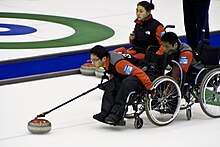
Team China at WWHCC 2009
Curling has been adapted for wheelchair users and people otherwise unable to throw the stone from the hack. These curlers may use a device known as a "delivery stick". The cue holds on to the handle of the stone and is then pushed along by the curler. At the end of delivery, the curler pulls back on the cue, which releases it from the stone.[72] The Canadian Curling Association Rules of Curling allows the use of a delivery stick in club play but does not permit it in championships.
The delivery stick was specifically invented for elderly curlers in Canada in 1999. In early 2016 an international initiative started to allow use of the delivery sticks by players over 60 years of age in World Curling Federation Senior Championships, as well as in any projected Masters (60+) Championship that develops in the future.[73]
Terminology
Terms used to describe the game include:
The ice in the game may be fast (keen) or slow. If the ice is keen, a rock will travel farther with a given amount of weight (throwing force) on it. The speed of the ice is measured in seconds. One such measure, known as "hog-to-hog" time, is the speed of the stone and is the time in seconds the rock takes from the moment it crosses the near hog line until it crosses the far hog line. If this number is lower, the rock is moving faster, so again low numbers mean more speed. The ice in a match will be somewhat consistent and thus this measure of speed can also be used to measure how far down the ice the rock will travel. Once it is determined that a rock taking (for example) 13 seconds to go from hog line to hog line will stop on the tee line, the curler can know that if the hog-to-hog time is matched by a future stone, that stone will likely stop at approximately the same location. As an example, on keen ice, common times might be 16 seconds for guards, 14 seconds for draws, and 8 seconds for peel weight.
The back line to hog line speed is used principally by sweepers to get an initial sense of the weight of a stone. As an example, on keen ice, common times might be 4.0 seconds for guards, 3.8 seconds for draws, 3.2 for normal hit weight, and 2.9 seconds for peel weight. Especially at the club level, this metric can be misleading, due to amateurs sometimes pushing stones on release, causing the stone to travel faster than the back-to-hog speed.
Champions and major championships

World Women's Championship trophy
|
|
Notable curling clubs
Bemidji Curling Club – Bemidji, Minnesota, Home of the 2006 United States Men's & Women's Olympic Curling Teams
Broomstones Curling Club – Wayland, Massachusetts
Chicago Curling Club – Chicago, Illinois
Dakota Curling Club – Burnsville, Minnesota – a leading example of the development of new curling clubs on arena ice in the USA
Detroit Curling Club – Ferndale, Michigan
Duluth Curling Club – Duluth, Minnesota – Home of the 2018 United States Men's Gold Medal Olympic Curling Team
Garrison Golf and Curling Club, Kingston, Ontario
Grand National Curling Club – Organization in the United States covering clubs on the east coast
Granite Curling Club – Winnipeg, Manitoba
Granite Curling Club – Seattle, Washington, the only dedicated curling facility on the west coast of the United States
Ice Melters Curling Club – England
Markinch Curling Club – Fife, Scotland
Mayflower Curling Club – Halifax, Nova Scotia
Milwaukee Curling Club – Mequon, Wisconsin — The oldest curling club in the U.S. – Since 1845
Ottawa Curling Club – Ottawa, Ontario
Potomac Curling Club – Laurel, Maryland – Near Washington, D.C
Pittsburgh Curling Club – Pittsburgh, Pennsylvania – Established in 2002
Plainfield Curling Club – South Plainfield, New Jersey
Rideau Curling Club – Ottawa, Ontario
Royal Caledonian Curling Club – Scotland, the official Mother Club of curling
Royal Montreal Curling Club – Montreal, Quebec, the oldest active athletic club in North America
Royal City Curling Club – New Westminster, British Columbia
Saint Paul Curling Club – St. Paul, Minnesota – Founded in 1885. Club with largest active membership in the United States (over 1000 members).
Utica Curling Club – Utica, New York
Kilsyth Curling Club – the first constituted curling club in the world
Wausau Curling Club – Wausau, Wisconsin – Home of the Tietge Bonspiel, the oldest and largest high school curling bonspiel in the U.S.
In popular culture
The Beatles participate in a game of curling during one scene of their 1965 film Help!. The villains booby-trap one of the curling stones with a bomb; George sees the "fiendish thingy" and tells everyone to run. The bomb eventually goes off after a delay, creating a big hole in the ice.
Curling is featured prominently in "Boy Meets Curl", the twelfth episode of the comedy series The Simpsons' twenty-first season. The episode aired on the Fox network in the United States on 14 February 2010.[74]
Men with Brooms is a 2002 Canadian film that takes a satirical look at curling.[75] A TV adaptation, also titled Men with Brooms, debuted in 2010 on CBC Television.[76]
The Corner Gas episode "Hurry Hard" involves the townspeople of Dog River competing in a local curling bonspiel for the fictitious "Clavet Cup". The episode also features cameos by Canadian curlers Randy Ferbey and Dave Nedohin.
See also
- Glossary of curling
- Grand Slam of Curling
- List of curlers
- World Curling Federation
- University and college curling
- Women's curling
Notes
^ "Curling Makes Gains in U.S. Popularity". Yahoo! Sports. 19 November 2011. Archived from the original on 2 March 2014..mw-parser-output cite.citation{font-style:inherit}.mw-parser-output q{quotes:"""""""'""'"}.mw-parser-output code.cs1-code{color:inherit;background:inherit;border:inherit;padding:inherit}.mw-parser-output .cs1-lock-free a{background:url("//upload.wikimedia.org/wikipedia/commons/thumb/6/65/Lock-green.svg/9px-Lock-green.svg.png")no-repeat;background-position:right .1em center}.mw-parser-output .cs1-lock-limited a,.mw-parser-output .cs1-lock-registration a{background:url("//upload.wikimedia.org/wikipedia/commons/thumb/d/d6/Lock-gray-alt-2.svg/9px-Lock-gray-alt-2.svg.png")no-repeat;background-position:right .1em center}.mw-parser-output .cs1-lock-subscription a{background:url("//upload.wikimedia.org/wikipedia/commons/thumb/a/aa/Lock-red-alt-2.svg/9px-Lock-red-alt-2.svg.png")no-repeat;background-position:right .1em center}.mw-parser-output .cs1-subscription,.mw-parser-output .cs1-registration{color:#555}.mw-parser-output .cs1-subscription span,.mw-parser-output .cs1-registration span{border-bottom:1px dotted;cursor:help}.mw-parser-output .cs1-hidden-error{display:none;font-size:100%}.mw-parser-output .cs1-visible-error{font-size:100%}.mw-parser-output .cs1-subscription,.mw-parser-output .cs1-registration,.mw-parser-output .cs1-format{font-size:95%}.mw-parser-output .cs1-kern-left,.mw-parser-output .cs1-kern-wl-left{padding-left:0.2em}.mw-parser-output .cs1-kern-right,.mw-parser-output .cs1-kern-wl-right{padding-right:0.2em}
^ Wetzel, Dan (19 February 2010). "Don't take curling for granite". Yahoo! Sports. Archived from the original on 25 February 2010. Retrieved 4 August 2012.
^ "'Chess on ice'". Princeton Allumni Weekly. 28 January 2009. Archived from the original on 23 July 2011. Retrieved 10 October 2010.
^ "Chess on ice". The Curling News. 22 June 2007. Archived from the original on 15 May 2011. Retrieved 10 October 2010.
^ "Wooden Curling Stone". Wisconsin Historical Society. 23 February 2006. Archived from the original on 5 November 2010. Retrieved 14 October 2010.
^ "The world's oldest curling stone". The Stirling Smith Art Gallery and Museum. Retrieved 15 February 2018.
^ "History of the Game". Scottish Curling. Retrieved 14 February 2018.
^ Eberlin, Amy. "The Flemish and the game of 'curling'". Scotland and the Flemish People. University of St Andrews. Retrieved 16 February 2018.
^ Kerr, John (1890). The History of Curling: And Fifty Years of the Royal Caledonian Curling Club. Edinburgh: David Douglas. p. 79. Retrieved 14 February 2018.
^ Adamson, Henry. "The muses threnodie, or, mirthfull mournings, on the death of Master Gall Containing varietie of pleasant poëticall descriptions, morall instructions, historiall narrations, and divine observations, with the most remarkable antiquities of Scotland, especially at Perth By Mr. H. Adamson".
^ "Curling". Olympic Games. Retrieved 14 February 2018.
^ "SND". Dsl.ac.uk. Archived from the original on 7 March 2012. Retrieved 4 August 2012.
^ Kerr, John (1890). History of curling, Scotland's ain game, and fifty years of the Royal Caledonian Curling Club. Edinburgh: David Douglas. p. 115. Retrieved 16 February 2018.
^ "Kilsyth Curling History". Paperclip.org.uk. Archived from the original on 5 February 2012. Retrieved 4 August 2012.
^ "Curling: History". Olympic Sport History. International Olympic Committee. 4 February 2018. Retrieved 7 May 2018.
^ Ramsay, John (1882). An Account of the Game of Curling, with Songs for the Canon-Mills Curling Club. Edinburgh. Retrieved 16 February 2018.
^ "Wooden Curling Stone". Wisconsin Historical Society. 23 April 2013. Retrieved 14 February 2018.
^ Kerr, John (1890). History of curling, Scotland's ain game, and fifty years of the Royal Caledonian Curling Club. Edinburgh: David Douglas. Retrieved 16 February 2018.
^ Cairnie, J. (1833). Essay on curling, and artificial pond making. Glasgow: W. R. McPhun. Retrieved 16 February 2018.
^ Watson, Thomas (1894). Kirkintilloch, town and parish. Glasgow: J. Smith. p. 312. Retrieved 13 October 2017.
^ Bell, Henry Glassford (1874). The Poetical Works of David Gray. J. Maclehose. pp. 16–17. Retrieved 11 August 2016.
^ Schorstein, Jon (director). "The Grand Match". Moving Image Archive. National Library of Scotland. Retrieved 19 February 2018.
^ Nate Baker (ed.). The Book of Old Darvel and Some of its Famous Sons. Darvel: Walker & Connell. pp. 12–13.
^ ab Doug Maxwell. Canada Curls - An Illustrated History of Curling in Canada. Whitecap Books.
^ "The Royal Montreal Curling Club". Archived from the original on 6 July 2011.
^ "WCF rankings". Archived from the original on 20 June 2012.
^ Campbell, Scott (22 April 2015). "A brief curling club history". Arnprior Chronicle-Guide. Ontario. Retrieved 19 February 2018.
^ "Mixed Doubles curling confirmed for PyeongChang 2018 Olympics". World Curling Federation. Retrieved 18 January 2018.
^ Lattimer, George M., ed. (1932). "III Winter Olympic Games, Lake Placid 1932, Official Report" (PDF). pp. 255–258. Archived from the original (PDF) on 10 April 2008. Retrieved 14 August 2008.
^ "Canadians Win At Curling: Beat United States, 12 Games to 3, in Exhibition Series and after all olympic matches they have a giant ice orgy with all the countries!". The New York Times. 6 February 1932. Sports, p. 20. Archived from the original on 15 June 2011. Retrieved 13 August 2008.
^ abc "The Rules of Curling and Rules of Competition". World Curling Federation. June 2008. Archived from the original on 12 March 2010. Retrieved 7 March 2010.
^ Branch, John (17 August 2009). "Curlers Are Finicky When It Comes to Their Olympic Ice". The New York Times. Archived from the original on 6 October 2017.
^ "USA-Today: Curlers Play Nice and Leave No Stone Unturned" (Press release). Twin Cities Curling Association. Archived from the original on 2 September 2012.
^ "Smooth operators: They make Olympic ice nice". Today in Vancouver. MSNBC. 23 February 2010. Archived from the original on 4 October 2012.
^ "About Curling/Stones". Anchorage Curling Club. Archived from the original on 15 April 2012. Retrieved 4 August 2012.
^ "1881 Census entry for Haugh, Mauchline, Ayrshire GRO Ref Volume 604 EnumDist 1 Page 3". Scotland's People. Retrieved 19 February 2018.
^ "News". Kays of Scotland. Archived from the original on 26 February 2013. Retrieved 4 August 2012.
^ "Mauchline, 9 Barskimming Road, Kay's Curling Stone Factory". Canmore. Retrieved 19 February 2018.
^ "Welsh Stone Forum newsletter" (PDF). October 2004. Archived (PDF) from the original on 2 February 2014. Retrieved 26 January 2014.
^ ab "The History of Curling". Canadian Curling Association. 18 January 2013. Archived from the original on 10 February 2014. Retrieved 10 February 2014.
^ "Top curling teams say they won't use high-tech brooms". CBC News. 16 October 2015. Archived from the original on 22 October 2015. Retrieved 21 October 2015.
^ "Curling Canada bans broom heads with 'directional fabric'". Ctvnews.ca. Archived from the original on 1 January 2016. Retrieved 7 January 2016.
^ Ouellette, Jennifer (12 June 2016). "Here's the Physics Behind the 'Broomgate' Controversy Rocking the Sport of Curling". Gizmodo. Archived from the original on 12 June 2016. Retrieved 13 June 2016.
^ "Curling Shoes:Choosing a Slider". Archived from the original on 18 April 2012.
^ "Curling Explained to non Curlers by Cameron Scott". Sporting Life 360. 14 February 2010. Archived from the original on 9 February 2014. Retrieved 10 February 2014.
^ "Eight is Great! Asham World Curling Tour Events, Including Grand Slams, move to Eight-End Format". World Curling Tour. World Curling Tour. Archived from the original on 19 September 2016. Retrieved 18 September 2016.
^ "Rules of Curling for General Play". Canadian Curling Association. October 2014. Archived from the original on 29 November 2014. Retrieved 20 November 2014.
^ DeSaulniers, Darren (26 March 2010). "Ferraro's hack innovation remains curling standard". Ottawa Citizen. Pressreader.com. p. B5. Archived from the original on 4 September 2017.
^ Bannerman, Gordon (11 November 2013). "Curling: Stormont Loch hosts outdoor bonspiel". Daily Record. Retrieved 20 February 2018.
^ Syers, Edgar and Madge (1908). The book of winter sports. London: Edward Arnold. p. 29. Retrieved 17 February 2018.
^ Kerr, John (1890). History of curling, Scotland's ain game, and fifty years of the Royal Caledonian Curling Club. Edinburgh: David Douglas. p. 402. Retrieved 16 February 2018.
^ Paul Wiecek (7 March 2016). "Team of 'tuckers'". Winnipeg Free Press. Archived from the original on 8 March 2016.
^ ""Why Curlers Sweep the Ice"". Business Insider. 14 February 2014. Archived from the original on 20 August 2017. Retrieved 20 August 2017.
^ "Rules of Curling for General Play" (PDF). Canadian Curling Association. September 2007. Archived from the original (PDF) on 23 May 2016. Retrieved 7 March 2010.
^ "What is the five-rock rule?". Grand Slam of Curling. 19 September 2017. Retrieved 10 October 2018.
^ McCormick, Murray (3 February 2018). "Curling's new five-rock free guard zone rule designed to generate offence". National Post. Retrieved 10 October 2018.
^ Thiessen, Nolan (15 June 2018). "Thiessen Blog: Five-rock FGZ a Positive Change for Curling". Curling Canada. Retrieved 10 October 2018.
^ "Section 7 Basic Strategy". The Curling Manual. Retrieved 16 February 2018.
^ "Shooting Percentages". CurlingZone. Archived from the original on 27 September 2007.
^ "Curling 8 Ender". YouTube. Archived from the original on 22 September 2011. Retrieved 20 October 2010.
^ Harvey, George. "The Curlers". ArtUK. Retrieved 15 February 2018.
^ Harvey, George. "The Curlers". ArtUK. Retrieved 15 February 2018.
^ Levack, John. "The Curlers at Rawyards". ArtUK. Retrieved 15 February 2018.
^ "Dutch School". ArtUK. Retrieved 15 February 2018.
^ Hardie, Charles Martin. "Curling at Carsebreck". ArtUK. Retrieved 15 February 2018.
^ Maguire, John Elliot. "Curling Stone Workshop". ArtUK. Retrieved 15 February 2018.
^ McGhie, John. "The Curlers". ArtUK. Retrieved 15 February 2018.
^ "Curling;—a Scottish Game, at Central Park". The Museum of Fine Arts, Houston. Retrieved 16 February 2018.
^ "Kings of the World: The Curling Richardsons". CBC Television. 13 March 2004. Archived from the original on 28 April 2007.
^ "Spirit of Curling". RCMP Curling Club, Ottawa. Archived from the original on 17 May 2013. Retrieved 23 March 2013.
^ Pearson, Patricia (March–April 2009). "How one woman fell in love with curling". Best Health. Archived from the original on 9 February 2010. Retrieved 1 February 2010.
^ "Section 4 - Using a Throwing Device". The Curling School. Curltech. Archived from the original on 16 January 2017. Retrieved 16 December 2017.
^ World Masters Curling World Masters Curling| Archived 10 January 2016 at the Wayback Machine.
^ "Catch the fanfare of Fox February". The Futon Critic. 25 January 2010. Retrieved 25 January 2010.
^ "Men With Brooms IMDB Entry". Retrieved 8 February 2018.
^ Glennon, Morgan (5 January 2012). "Men With Brooms: Requiem for an Obscure Canadian Sitcom". Huffington Post. Retrieved 7 August 2012.
Further reading
.mw-parser-output .refbegin{font-size:90%;margin-bottom:0.5em}.mw-parser-output .refbegin-hanging-indents>ul{list-style-type:none;margin-left:0}.mw-parser-output .refbegin-hanging-indents>ul>li,.mw-parser-output .refbegin-hanging-indents>dl>dd{margin-left:0;padding-left:3.2em;text-indent:-3.2em;list-style:none}.mw-parser-output .refbegin-100{font-size:100%}
Mott, Morris; Allardyce, John (1989). Curling Capital Winnipeg and the Roarin' Game, 1876 to 1988. Winnipeg: University of Manitoba Press. ISBN 0-88755-145-9.
Richard, Pierre (2006). Une Histoire Sociale du Curling au Québec, de 1807 à 1980 (in French). Trois-Rivières: Université du Québec.
External links
| Wikimedia Commons has media related to Curling. |
Wikisource has the text of the 1911 Encyclopædia Britannica article Curling. |
- World Curling Federation
- CBC Digital Archives – Curling: Sweeping the Nation
- Bonspiel! The History of Curling in Canada at Library and Archives Canada
curling stones, Smithsonian Center for Folklife and Cultural Heritage.
The Game Of The Magic Broom, March 1944 one of the first magazine articles to introduce the game of curling to the American public
The Canadian Curler's Manual transcription of 1840 text
Sportlistings.com - World Curling Federation Directory listing

